
![]()
| Back to main page |
|
| Die LIMUS Umwelttechnik
GmbH hat Ihre Geschäftstätigkeit aufgegeben. Wir von der PONDUS Verfahrenstechnik GmbH möchten Ihnen aber gern weiterhin mit Rat und Tat zur Seite stehen. |
 |
| Wir freuen uns über Ihren Besuch. Sie werden automatisch zu uns weitergeleitet. |
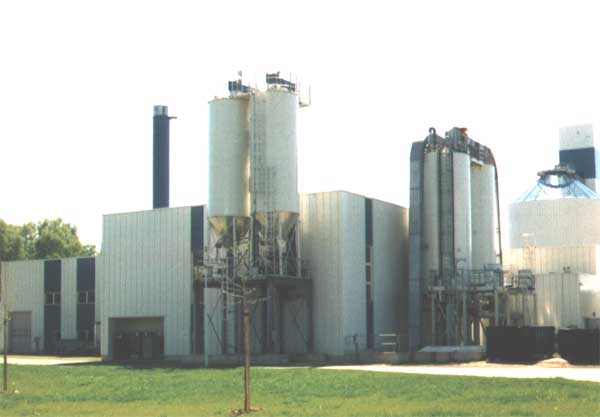
The Chemnitz drying plant
Drying dewatered sewage sludge to minimalise its volume has become an important process in many sewage treatment plants. Since disposal costs have risen, the process is now finding widespread use as opposed to former times when it was rarely applied because of the significant energy requirements and the crucial problem of smell nuisance.
Until recently emphasis was placed on the disposal of the dried sewage sludge by tipping. Nowadays, however, all forms of disposal have to be taken into account - agriculture, tipping, incineration. Partial drying of the sewage sludge to approx. 50% solid matter was sufficient for tipping in the past, but this is now only acceptable in special cases. Nowadays a product consisting of 90% solid matter is required that can be stored for spreading as a uniform, dust-free granulate in agriculture. The influence of heat during the drying process results in a perfectly hygienic product.
The physically-conditioned high thermal input for drying can be kept to a minimum by appropriate process technologies. This is encouraged by the peculiarities of sewage sludge treatment by anaerobic sludge stabilisation, namely production of digestergas and higher thermal requirements. The gas can be used more economically as a fuel for drying than in gas engines. The recovery of the exhaust heat offers a 2-fold benefit as it can be used to heat both the digestion tank and the buildings.
The sewage treatment plant should not be burdened by vapour condensate, and every precaution must be taken to reliably prevent smell emissions.
Complete drying of the sewage sludge invariably results in the formation of dust, which may not release into the atmosphere. Moreover, the combustibility of the material requires appropriate protective measures against the danger of explosions and fires.
On account of their outstanding properties we only use contact dryers where the heat used to dry the dewatered sludge is indirectly supplied via heating surfaces. The resulting advantages include:
Practice-proven, robust and reliable equipment.
Low heat consumption which is just above the theoretical value and significantly lower than that of systems based on gas-circulation.
Heat generation by proven thermal oil or steam boilers, no high-temperature heat exchangers.
The vapours contain hardly any condensable gases (leakage air) so that almost all the heat used for drying can be recovered for heating purposes.
The dryer as well as the connected processing equipment and conveyors have a very low gas volume containing dust-laden vapours. Consequently, the explosion potential and fire hazard is minimal.
Low power consumption as large volumes of gas do not have to be circulated.With contact dryers the temperature of the full dried product is in the order of 110°C, and under certain circumstances this can even be reduced. Consequently, the vapours contain few organic substances. A large proportion of these volatile substances are already dissolved in the preceding sludge and were therefore invariably stripped off with the water vapour.
A good granular product can be produced with contact dryers. It is an established fact that dust is formed in the course of all drying processes. The granular quality depends upon optimal separation of the different dried product fractions and corresponding granulation of the in-fed material. Uniform granules, therefore, is less a matter of the dryer type but rather a suitable periphery.
We use thin-film, linear or disk dryers. We are completely free to select the actual type so that the dryer can always be optimally adapted to the given application. The dryers are always horizontal and incorporate rotating elements:
Thin-film dryers: Suitable for drying up to a point of 65% solid matter. Thin-film dryers have a high specific evaporation capacity provided that the product is liquid. Drying can pass through the adhesion phase to produce a good granulate without requiring any additional equipment.
Linear dryers: Their slow rotating speed and product-gentle manner of operation make them ideal as the final dryer behind the thin-film dryer.
Disk dryers: With recirculation for complete drying to a level of 90% solid matter. Previously dewatered sludge is added to the dried product and granulated, thereby avoiding product adhesion.
The heat required for drying is generated in a boiler by firing digestergas, natural gas or fuel oil. The exhaust heat from gas turbines or gas engines can also be used for this purpose. The heat can be transferred by oil or steam. Thermal oil is more suitable for sewage sludge treatment plants because operation is nearly pressureless so that it does not have to be operated by a certificated boilerman. Steam results in process-conditioned losses which have to be replaced by topping up with boiler water that has to be produced from the municipal water supply by a separate feed-water treatment installation.
The sewage sludge, dewatered to between 20 and 30% solid matter, is usually removed from a silo and, depending upon the condition and the layout of the plant, it is fed into the dryer by a screw conveyor or slurry dosing pump. Obviously, a short distance between silo and dryer is advantageous.
The dry material can be sieved to obtain a certain grain size or the dust can be removed, depending upon the customer's requirements. The material must be cooled to prevent spontaneous ignition. The dry material is conveyed by a pneumatic system or by screw and bucket conveyors, stored in silos for transfer to transport containers or stored in "Big Bags".
Various circuits are available to treat vapours and recover the heat contained in the vapours for renewed use. In many cases this recovered heat is used to produce hot water with an in-feed temperature of up to 90°C to cover the thermal requirements for heating the Digestion process and buildings.
Excessive vapours can also be used to preheat the sludge prior to dewatering. This results in significant advantages when centrifuges are used. Moreover, the thermal requirements for drying are reduced.
The remaining vapours are extracted by a fan, thereby producing a vacuum throughout the drying system to prevent emission of smells in the boiler room or from the biofilter.
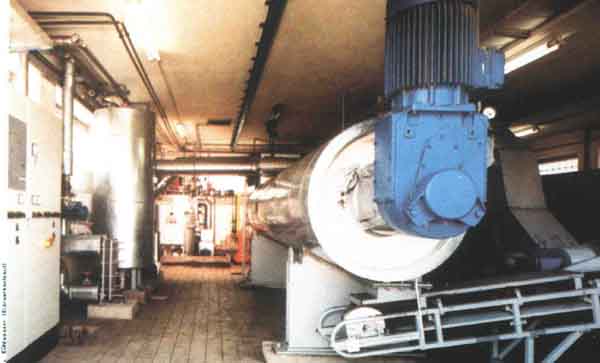
The Niederkrüchten drying plant
Thin-film plus linear dryer (Niederkrüchten system)
This process was developed by LIMUS and registered for a patent. It is characterised by its exceptional simplicity and permits unmanned operation, i.e. round-the-clock operation without additional personnel. This also means that the size of the dryer can be scaled down to reduce investment costs. Moreover, the digestergas continuously produced can be used without extensive intermediate storage. This process (shown below in its basic configuration) is ideal for small to medium-sized plants.
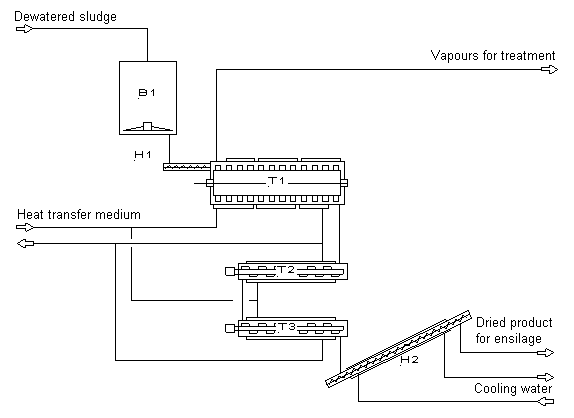
The dewatered sewage sludge is
removed from the B1 transfer silo by the H1 screw conveyor and
directly dosed into the T1 thin-film dryer. The dewatered sludge
is dried and granulated in a single operation.
A dried product with 65% solid matter is discharged by the
thin-film dryer which is followed by the linear dryers T2, T3,
..., which gently dry the product to its final state. The
material is cooled in the H2 screw conveyor and finally
transported to the silos.
The novel feature is the fact that a relatively low volume of air
(10 to 30 weight-% of the total amount of arising water vapour),
is drawn together with the water vapour through the H2 cooling
screw conveyor and the T3, T2 and T1 dryers in counterflow of the
product that is being dried, i.e. throughout the entire
installation. This measure not only supports product drying at
high levels of solid matter but also keeps the product
temperature low and improves the efficiency of the H2 cooler.
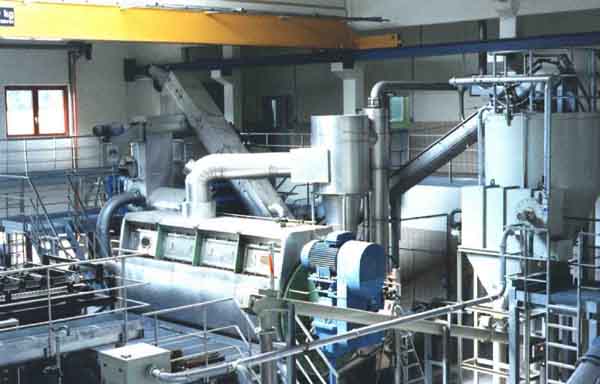
The Steinen drying plant
Disk dryer with recirculation and sieving
The following describes the standard circuit of this process which is preferable for larger installations. The H1 dosing screw removes the dewatered sewage sludge from the B1 transfer silo and supplies it to the R1 mixer where it is mixed thoroughly with the dried sludge to produce a product of approx. 65% solid matter that will no longer stick together.
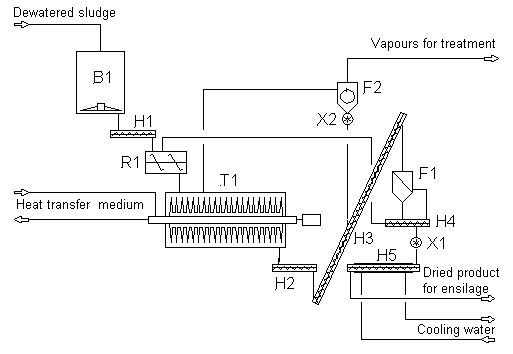
The mixed product drops through the T1 disk dryer where heat extracts the water contained in the sludge. The dried material is removed from the dryer by the H2 screw conveyor for metered transfer to the H3 ascending screw conveyor which discharges the material onto the F1 screen. In the simplest instance the material is separated into two fractions: The fine-grain fraction and a large proportion of the coarse grain fraction are returned by the H4 screw conveyor to the R1 mixer for renewed mixing with dewatered sludge. The actual final product is removed from the system via H4 and the X1 cellular wheel, cooled in the H5 screw conveyor and finally transported to the silos.
The vapours formed during drying are transferred for further processing after the F2 cyclone has removed the dust. The dust is returned to the system via the X2 cell-wheel sluice.
Heating media: Heat-transfer oil from 160 to 220°C
Steam from 4 to 12 barDegree of drying: Partial to approx. 50% solid matter
Full to approx. 90% solid matterThermal input: approx. 3,000 kJ/kg evaporated water Heat recovery: >90% of the absorbed heat Dryer power consumption, incl. heat generation and vapour treatment depending upon the process: approx. 60 to 80 kWh/1,000 kg evaporated water